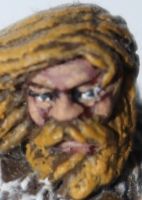Da Krimson Barun wrote:
will another company get it? and can they use gw moulds?
I doubt that.Such is GW's corporate culture, that I believe they'll prefer to just simply destroy/recycle all the existing moulds and resin masters, rather than sell them/the range to another Company and risk that company becoming successful enough to rival GW.
Quote:
Is there a company that can even AFFORD the price new line will want?
That depends.
After the hype of the Hobbit movies dissipates and the public/ the market's love for all things Tolkien fades, the value of a LOTR licence will fall. If New Line wants to continue selling the licence(s), then they'll need to adjust their expectations accordingly and charge significantly less, in which case there'll be more competition.
If however there is a real prospect of future films, such as the film rights to the Silmarillion and Children of Hurin being sold (which is unlikely to happen in the near future), then that will naturally prop up the value. Take the inter trilogy period between LOTR and The Hobbit. The film rights for the Hobbit had been sold, pre-production work was underway for a long time and it was known that PJ wanted to film the Hobbit. Even with a decade long delay, there was always a very real prospect that we would get a new set of films for The Hobbit, and so the licence remained valuable and GW retained it, at considerable cost, in the hopes of benefiting from a new film bubble like the LOTR bubble.
If there was never any prospect of the Hobbit being filmed, e.g. if the film rights remained with The Tolkien Estate (Christopher Tolkien is reportedly vehemently opposed to ALL the films of his father's work and he wants to block films of the Children of Hurin and the Silmarillion) then GW would have dropped the licence like a hot potato after the LOTR bubble burst and its profits began to fall.
Ideally my preference would be to split the licence into Wargame Rules, and a range of licenced miniatures.
Let one company write a set of wargaming rules systems, and another (maybe more than one) company produce ranges of miniatures. Make them cooperate and work together.
Getting more companies involved and giving them licences to produce LOTR miniatures and wargames means better competition and more variety and choice for the consumer. This way, no single company would have a monopoly on LOTR wargames and wargaming miniatures.
Gripping Beast does this with its various wargames systems. Gripping Beast produces whole ranges of miniatures, but outsources to another company, Studio Tomahawk, which writes and publishes the actual Wargames. And it works quite well for them.
Gene Parmesan wrote:
[...]
Knight Models, as we know, have some licencing rights. They are still molding in metal. This leads me to believe less about the cost of a licence, and more about GW secretly justifying higher profit margins, in a dwindling market.
But the Wargaming market is growing, not dwindling. Its GW's share of that market which is dwindling.
 Top
Top Top
Top Top
Top Top
Top Top
Top Top
Top Top
Top Top
Top






